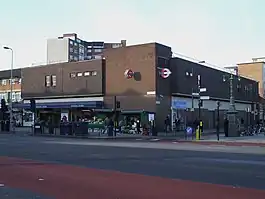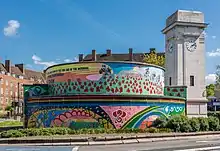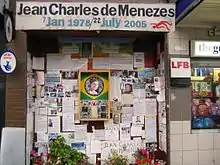Stockwell tube station
Stockwell is a London Underground station in Stockwell in the London Borough of Lambeth. It is located on the Northern line between Oval and Clapham North stations, and on the Victoria line between Brixton and Vauxhall stations.[6] It is in Travelcard Zone 2.[6]
| Stockwell | |
|---|---|
 The station entrance | |
 Stockwell Location of Stockwell in Greater London | |
| Location | Stockwell |
| Local authority | Lambeth |
| Managed by | London Underground |
| Owner | London Underground |
| Number of platforms | 4 |
| Fare zone | 2 |
| London Underground annual entry and exit | |
| 2018 | |
| 2019 | |
| 2020 | |
| 2021 | |
| 2022 | |
| Key dates | |
| 4 November 1890 | Opened (C&SLR, as a terminus) |
| 3 June 1900 | Became through station |
| 29 November 1923 | station closed for rebuilding |
| 1 December 1924 | station reopened |
| 23 July 1971 | Opened (Victoria line) |
| Other information | |
| External links | |
| WGS84 | 51.4725°N 0.122°W |
The station opened on 4 November 1890 as the southern terminus of the City and South London Railway, the first successful deep-level tube in London.[note 1] The Victoria interchange opened on 23 July 1971 when that line was extended south from Victoria towards Brixton. The station is known for its World War II air-raid shelters, and for being the location of the shooting of Jean Charles de Menezes.
History
Original station
Stockwell station was ceremonially opened on 4 November 1890 by the Prince of Wales (later King Edward VII), as the most southerly station on the City and South London Railway (C&SLR) – London's first successful deep-level tube railway. Passenger services began just over one month later on 18 December.[7]
The station was built with a single island platform with tracks on either side, an arrangement that today is rarely used underground on the network but which still exists at Clapham North and Clapham Common. Stockwell's original platform was further north than the new ones, and trains pass it today. The other terminus of the C&SLR line was King William Street in the City of London. On 3 June 1900, when an extension to Clapham Common was opened, Stockwell ceased to be a terminus.[8] A flight of stairs at the south end of the platform was also added to take passengers to a subway that passed over the new northbound tunnel and joined the lift shaft at a higher level.
The original building, designed by T. P. Figgis, was similar to – but larger than – the existing surface building at Kennington[9] with a domed roof to the original lift shaft. The two lifts each carried 50 people to and from the platforms until their replacement by escalators in 1924.[10] The station was modernised in advance of the 1926 extension from Clapham Common to Morden. A new surface building was constructed by Charles Holden on the original site.[11] The original station platforms were closed on 29 November 1923[12] and platforms sited to the south of the original were opened on 1 December 1924.[13] At the same time the platforms were rebuilt to a larger diameter – and with a single platform in each tunnel – south of the original station tunnel.
New station
.jpg.webp)
The station was expanded to accommodate the Victoria line, whose extension from Victoria to Brixton opened on 23 July 1971.[14] Parallel cross-platform interchanges were provided between the two lines in both directions and the 1920s surface buildings were replaced by a modern structure.[15] A third escalator was added to the existing pair, by constructing an additional shaft. Some construction work disturbed shelter tunnels constructed during war, that had to be re-sited.[16] A British Transport Police (BTP) station was later built above the station in 1985, as part of a BTP initiative to increase police presence across the Underground.[17] The Victoria line platforms have tiling designed by Abram Games showing a swan, a reference to the nearby Swan public house.[18]
The station has ticket halls, three escalators, seven gates, 13 payphones, a Wi-Fi service,[19] 9 vending machines and a photo booth.[20] The ticket hall has electronic departure boards.[20] The ticket office was closed in early 2015 as part of the TfL investment programme.
Nearby infrastructure
Deep-level air-raid shelter

Stockwell is one of eight London Underground stations with an adjacent deep-level air-raid shelter, constructed during World War II.[21] The shelter is below the current station, and comprises two parallel tunnels, each approximately six times the length of the current platform. These tunnels are 16 feet 6 inches (5.03 m) in diameter (wider than the current platforms), split horizontally into upper and lower levels, with various connecting and branch tunnels used for medical posts, lavatories, and ventilation.[22]
The total capacity of the shelter was around 4,000 people. Access was via the station as well as two further entrance shafts containing spiral staircases, one of which is located at the middle of the junction of South Lambeth Road and Clapham Road, and the other on Studley Road. The shelter was completed in September 1942, and was used by the Government until 1944 when it was opened to the public.[23] It was used for one year as a shelter. After the war it was used for a period to billet military personnel. One of the entrances has been brightly decorated and is a recognisable local landmark.[22]
Branch tunnel and depot

Just north of the station there is a branch tunnel which led to a nearby generating station (closed 1915), depot and workshop located at the junction of Stockwell and Clapham Roads.[note 2] The tunnel was very steep with an incline of 1:3.5, so rolling stock was originally pulled up to the surface using a wire rope and a winch. This system was replaced in 1907 by a hydraulic lift, which could carry one locomotive or one carriage.[24]
During the 1920s, the line was closed for reconstruction and the depot was used as a working site for transporting spoil, equipment and works traffic in and out of the tunnels.[25] The depot and lift were finally taken out of use at the end of 1924. The incline tunnel and the lift shaft were plugged on the surface and several blocks of flats were constructed on the old depot site by the LCC. These flats still stand (as of 2023), as does one retaining wall of the old depot with distinctive curved buttresses.
Incidents
.jpg.webp)

On 22 July 2005, Jean Charles de Menezes, a Brazilian electrician living in London, was shot dead by plainclothes police officers at Stockwell station. This incident came a day after the failed 21 July 2005 London bombings occurred on tube trains and a bus in London. It later emerged that it was a case of mistaken identity on the part of the police and that Menezes had nothing to do with the attacks.[26][27] In the immediate aftermath of the shooting a small shrine to de Menezes was created by mourners outside the station. This evolved into a permanent memorial mosaic which was unveiled on 7 January 2010 at the station. It was made by local artist, Mary Edwards, with the help of Menezes' cousin, Vivian Figueiredo, as well as Chrysoula Vardaxi.
Services and connections
Train frequencies vary throughout the day. However, Northern line trains generally operate every 4–6 minutes between 06:06 and 00:12 in both directions[28][29] while Victoria line trains generally operate every 3–5 minutes between 06:02 and 00:20 in both directions.[30][31] There is also 24-hour Night Tube service on both lines on Friday and Saturday evenings.
The station is served by London Bus routes 2, 50, 88, 155, 196, 333, 345 and P5, and also by night routes N2 and N155.[32] Additionally, bus routes 88 and 345 have a 24-hour service.[32]
Notes and references
Notes
- The first deep-level tube was the short lived cable hauled Tower Subway.
- Greathead's plan presented to the Institution of Civil Engineers, shows the depot and generating station were on the east side of Clapham Road/Kennington Park Road, approximately where Stockwell Gardens is today.
References
- "Station Usage Data" (CSV). Usage Statistics for London Stations, 2018. Transport for London. 23 September 2020. Archived from the original on 14 January 2023. Retrieved 11 October 2023.
- "Station Usage Data" (XLSX). Usage Statistics for London Stations, 2019. Transport for London. 23 September 2020. Archived from the original on 9 November 2020. Retrieved 9 November 2020.
- "Station Usage Data" (XLSX). Usage Statistics for London Stations, 2020. Transport for London. 16 April 2021. Retrieved 1 January 2022.
- "Station Usage Data" (XLSX). Usage Statistics for London Stations, 2021. Transport for London. 12 July 2022. Retrieved 7 September 2022.
- "Station Usage Data" (XLSX). Usage Statistics for London Stations, 2022. Transport for London. 4 October 2023. Retrieved 10 October 2023.
- Standard Tube Map (PDF) (Map). Not to scale. Transport for London. November 2022. Archived (PDF) from the original on 7 November 2022. Retrieved 12 November 2022.
- Day & Reed 2008, pp. 42, 44.
- Wolmar 2012, pp. 144–145.
- Lawrence 1994, pp. 20–23.
- Lawrence 1994, p. 50.
- Day & Reed 2008, p. 96.
- Butt 1995, p. 221.
- Day & Reed 2008, p. 93.
- Demuth 2004, p. 26.
- Day & Reed 2008, p. 171.
- Horne 1988, p. 52.
- Webb, Barry; Laycock, Gloria (14 July 2011). Reducing Crime on the London Underground - An Evaluation of Three Pilot Projects (Report). Home Office. p. 6.
- Martin 2012, p. 237.
- Stockwell Underground Station
- Stockwell Tube Station – Facilities
- Day & Reed 2008, p. 143.
- "Clapham Deep Shelters". The Clapham Society. Retrieved 27 April 2019.
- Wade, Stephen (2011). Air-Raid Shelters of World War II: Family Stories of Survival in the Blitz. Casemate Publishers. p. 153. ISBN 978-1-848-84327-1.
- Wolmar 2012, p. 136.
- Connor 1999, p. 118.
- Fresco, Adam; Syal, Rajeev; Bird, Steve (23 July 2005). "Suspect shot dead 'had no bomb'". The Times. London. p. 4. Retrieved 12 September 2018.
- "De Menezes memorial mosaic to be permanent". The Times. London. 11 December 2009. p. 37. Retrieved 12 September 2018.
- "Northern line timetable: From Stockwell Underground Station to Oval Underground Station". Transport for London. Retrieved 19 February 2015.
- "Northern line timetable: From Stockwell Underground Station to Clapham North Underground Station". Transport for London. Retrieved 19 February 2015.
- "Victoria line timetable: From Stockwell Underground Station to Vauxhall Underground Station". Transport for London. Retrieved 19 February 2015.
- "Victoria line timetable: From Stockwell Underground Station to Brixton Underground Station". Transport for London. Retrieved 19 February 2015.
- "Buses from Stockwell" (PDF). Transport for London. February 2011. Archived from the original (PDF) on 7 March 2016. Retrieved 26 May 2018.
Bibliography
- Butt, R. V. J. (October 1995). The Directory of Railway Stations: details every public and private passenger station, halt, platform and stopping place, past and present (1st ed.). Sparkford: Patrick Stephens Ltd. ISBN 978-1-85260-508-7. OCLC 60251199. OL 11956311M.
- Connor, J.E. (1999). London's Disused Underground Stations. Capital Transport. ISBN 1-85414-250-X.
- Day, John R; Reed, John (2008) [1963]. The Story of London's Underground. Capital Transport. ISBN 978-1-85414-316-7.
- Demuth, Tim (2004). The Spread of London's Underground. Capital Transport. ISBN 1-85414-277-1.
- Horne, M.A.C. (1988). The Victoria Line – A Short History. Douglas Rose. ISBN 978-1-870-35402-8.
- Lawrence, David (1994). Underground Architecture. Capital Transport. ISBN 978-1-854-14160-6.
- Martin, Andrew (2012). Underground, Overground. Profile Books. ISBN 978-1-846-68478-4.
- Wolmar, Christian (2012) [2004]. The Subterranean Railway: How the London Underground Was Built and How It Changed the City Forever. Atlantic Books. ISBN 978-0-857-89069-6.
External links
| Preceding station | Following station | |||
|---|---|---|---|---|
| Oval | Northern line | Clapham North towards Morden | ||
| Brixton Terminus |
Victoria line | Vauxhall towards Walthamstow Central | ||